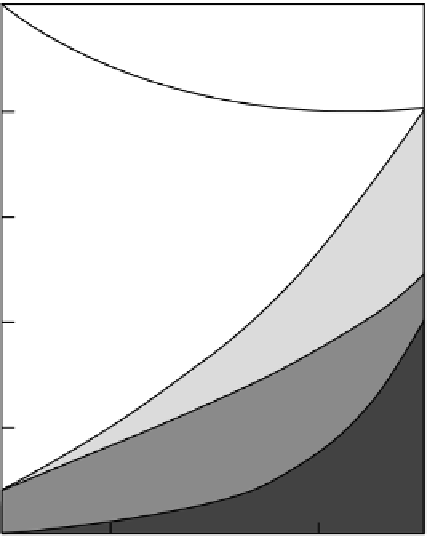Agriculture Reference
In-Depth Information
2500
2000
UNMET POTENTIAL FOR
EVAPORAT ION OR
EVAPOTRANSPIRATION
1500
EVAPO-
TRANSPIRATION
1000
500
EVAPORAT ION
RUNOFF
0
ARID
SEMIARID
SUBHUMID
HUMID*
CLIMAT IC REGION
fIguRe 19.5
Estimated amounts of runoff, evaporation, evapotranspiration, and potential
evapotranspiration for different climatic regions. (From V.M. Ponce, 1995,
Soil and Water
Conservation Journal
50:422
-
431.)
efficient use of water must maximize the portion of total water that is used as evapo-
transpiration, and this requires a reduction in evaporation during the year when a
crop is not growing. If salinity is a problem, some water must percolate through the
soil and move below the root zone to prevent salts accumulating to a detrimental
concentration. This leaching requirement, however, should be kept as low as feasible
to maximize the efficient use of water. If salinity is not a problem, efforts should be
made to prevent movement of water below the root zone. Likewise, runoff should be
prevented to the fullest extent feasible, particularly in areas where water is limiting.
A hypothetical water management example by Howell (1990) is presented in
Figure 19.6 and is extremely useful in understanding water use efficiency under a
variety of scenarios. In this example, the Q
o
shows a case where the sum of water use
from available soil water at time of seeding and rainfall during the growing season
totaled 250 mm, and Q
m
is the total field water supply of 1400 mm that includes
the 250 already described plus 1150 mm of applied irrigation water. The yield of
aboveground biomass produced and the yield of grain produced by a dryland crop
are represented by P and Y, respectively. In this example, P was 6 Mg ha
−1
, and Y
was 2 Mg ha
−1
. Therefore, the harvest index (grain yield/total aboveground biomass)

